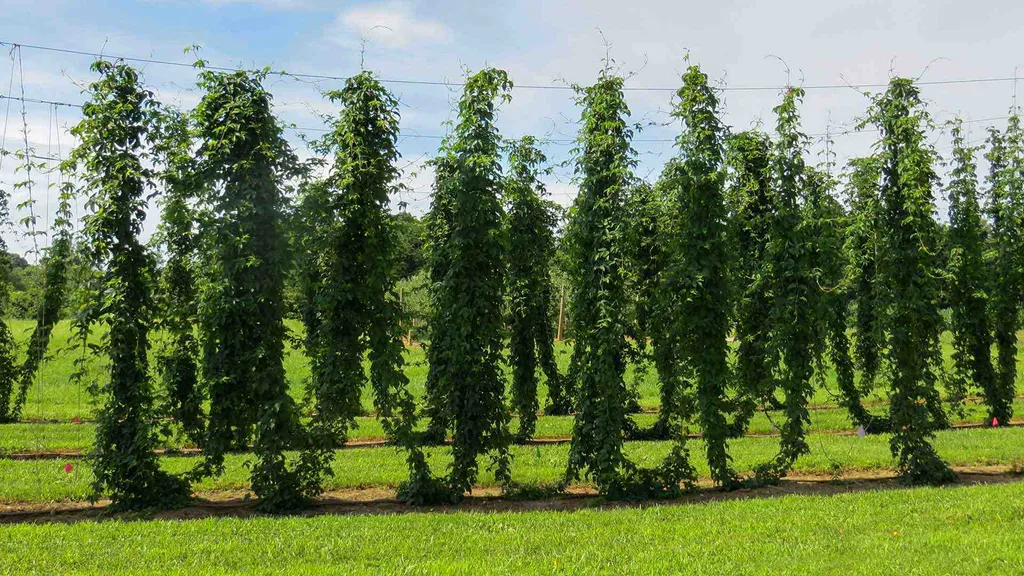- March 16, 2023
- By Maggie Haslam
The staff at Milkhouse Brewery’s tap room is used to people clamoring for pints of hazy IPA, orange-spiked hefeweizen and Baltic porter. But lately, those favorites have taken a back seat to new brews with literal Maryland roots: the Monocacy hop, a seemingly indestructible, prolific native hop strain that hid in plain sight for close to a century and is now being championed by UMD researchers as a bellwether for Maryland’s booming beer industry.
Since debut last month at Mount Airy, Md.’s Milkhouse—where it can be found exclusively in two lagers and a pale ale—the hop has lured hordes of beer enthusiasts to the Terp-owned independent brewery to drink in its delicate flavor, reminiscent of the smooth noble hops of central Europe.
“It’s different from any hop I’ve ever brewed with,” said Tom Barse ‘77, owner of Milkhouse, who has been brewing beer since 1972. “It has this verdant green earthiness to it that’s like walking into a flower shop. And people love it.”
The story behind the Monocacy hop began on a shorthorn cattle farm in Frederick, Md., where it had been growing wild and aggressively, overtaking fencing and nearly swallowing the farm’s chicken coop. A chance conversation with the owner—who recognized the cone-shaped flowers from his childhood in the Pacific Northwest—brought Barse out to procure some cuttings. He eventually brought the hop to Bryan Butler ‘84, a principal agent at the University of Maryland Agricultural Extension (UME) in Carroll County, who has been experimenting for years with different hop varieties on a modest half-acre “hop yard” at UMD’s Western Maryland Research and Education Center in Keedysville.
While Barse and Butler were initially skeptical of the hop’s provenance, a sample sent to the U.S. Department of Agriculture’s (USDA) Germplasm Repository returned with a surprising result: The plant was unlike any of the 629 genotypes found in the USDA ARS National Hop Collection, with characteristics similar to a wild American hop.

With the help of the agricultural consulting agency Grow & Fortify, Butler secured a two-year USDA Specialty Crops grant to fund research on the hop, which was named for the watershed that straddles both Frederick and Carroll counties; his team planted its first crop in the fall of 2021 and another in the spring of 2022, with overwhelming results.
“We really didn’t think we’d get anything the first year,” said Butler. “But the plants were so massive we couldn’t get them through our mobile hop harvester.”
The Monocacy hop is the type of discovery, said Butler, that could be a boon to Maryland’s burgeoning $917 million beer industry, but to the state’s overall agriculture trade as well, spurring longtime and fledgling farmers to cultivate not just hops, but barley and wheat.
The cone-shaped flower of the Humulus Lupulus plant, hops play a key role in keeping beer fresh and retaining a freshly-poured pint’s foamy head, and also provide the bitter, herbaceous flavor. UME has been providing various hops to Frederick-based Flying Dog since 2017 for the company’s seasonal “Field Notes” beer; this past year it worked with Maryland-based barley and wheat farmers to offer a 100% home-grown version, a rarity in the industry.
“Up until now, the local ingredients have been hit or miss, and I think a lot of local brewers have been turned off by the quality and quantity of what’s produced in Maryland,” he said. “This could change that.”
Beyond economics is the environmental impact. While Butler predicted it will take another three to five years to determine if Monocacy is suitable for commercial growing, early results demonstrate a plant seemingly made for Maryland: It’s easy to grow, tolerant of Maryland’s fickle climate and resistant to insects and diseases, like downy mildew, that torment Maryland farmers. That type of resilience means growers use less water, fertilizer and insecticide.
“From a sustainability perspective, it’s very exciting,” he said. “It shows a tremendous amount of promise.”
Beer lovers aren’t the only ones buzzing about Monocacy—so is Butler’s phone, receiving calls from Maryland breweries and homebrewers itching to get their hands on the hop. That process will take time, he cautioned, as UME continues to study and monitor Monocacy’s progress. Last week it added another row to its hop yard and will conduct additional research this fall with a handful of cooperative farms to experiment with different micro climates.
The hop, which is “open source” and part of the National Clonal Germplasm Repository, has also been shared with Cornell University to see how it fares in a cooler climate and to possibly spur further research on disease-resistant breeds.
The fall crop from UME’s hop yard, already emerging from the ground, thanks to Maryland’s mild winter, has been earmarked for Milkhouse, Heavy Seas and possibly a few other breweries, but Butler predicts their work will eventually bring Monocacy to anyone who wants it.
“My hope is that the Monocacy hop is to Maryland beer as Old Bay is to Maryland Crabs,” he said.
